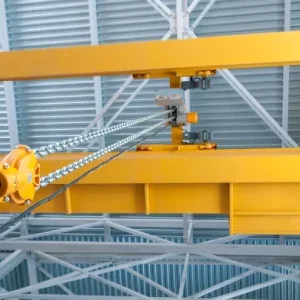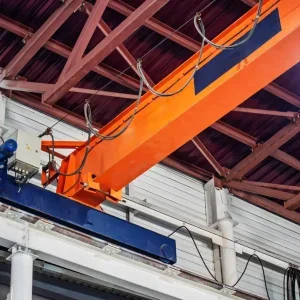The best known is perhaps the top running gantry crane. As the name implies, these run on the top of rails which are part of the crane gantry. The rails are at a high level approximating to the highest position of the crane hook. The gantry structure may be independent or an integral part of a building. The crane bridge, which spans across the gantry, can be of single girder or double girder design.
The single girder design is usually the simplest and cheapest, being made of a rolled steel beam and perhaps capped with a channel section for lateral stiffness. The hoist is carried by a trolley running on the bottom flange of the beam. This design is widely used although the maximum capacity and span are ultimately limited by the available beam sizes. The distance from the drawn up hook to the top of the beam is often greater than in double girder designs, although low headroom hoists can minimise this limitation.
Double girder crane designs can use the same rolled steel sections within the limits imposed by available sizes. For higher capacities and longer spans, box girders are the usual choice. The hoist is part of a crab which usually runs on rails on the top of the bridge beams so that, when drawn up to its maximum height, the hook is between the beams, keeping the headroom required to a minimum. This is usually an advantage but must be allowed for if the crane is to be used with a lifting beam or loads which might foul the underside of the beams when the hook is fully drawn up.
A goliath type crane is similar to a top running crane except that the crane bridge is supported by legs and the rails are at a low level, usually at or near ground level. Whilst the additional leg structure makes the crane more expensive, this is offset by the considerably cheaper low level rails. That advantage increases with increased track length making them particularly suitable for large outdoor stockyards. There is an additional hazard arising from travelling on low level rails which must be considered, but this can usually be addressed fairly easily and ground level rails can be advantageous compared to the obstruction caused by the columns of a high level gantry. As with the top running crane, they can be of single or double girder design with similar construction methods. Furthermore they can be designed with a cantilever at one or both ends.
A semi-goliath crane is a hybrid of a goliath and a top running crane with one end of the bridge supported by a high level gantry and the other by a leg running on a low level track. Typically they are used in an area adjoining a building and the high level gantry is integral with the building structure. They are therefore suitable for outdoor stockyards alongside a building but also for indoor use where a full span of the building is not required.
The next option is the under-slung crane, which runs on the bottom flanges of rolled steel beams which form the crane tracks. These are usually indoor cranes and the crane tracks are suspended from the building structure. They have the advantage of being able to cover part of the building span without obstructing the floor below. A modern variation of this type uses proprietary hollow track sections which enclose the load bearing trolley. These track sections can be used for the long travel tracks and also for the crane bridge. This variation is particularly suitable for light duty applications where the load is travelled by manually pushing it.
The under-slung arrangement allows the bridge of this type of crane to be designed with a cantilever at one or both ends. A cantilever can be fitted with a latching mechanism to connect to a matching section. This facilitates the transfer of loads from the crane to a static runway or, if two or more such cranes are running on parallel sets of tracks, from one crane to another.
The types described above are the most popular but there are many variations possible to suit particular situations. For example a double girder crane can be manufactured with the crab running between the bridge beams rather than on top of them.
Having understood the options for the structure of the crane the potential purchaser needs to consider the control options. The first of these is the position from which the crane is controlled. Before the advent of modern control systems, most electric overhead travelling cranes were cab controlled. There are still applications where cab control is the best option, in particular those where the crane is in continuous use or the application requires lengthy long travel movements. The disadvantage of cab control is that the operator needs to be continuously on duty when use is infrequent.
The usual arrangement is that the cab is fixed at one end of the crane bridge and travels with the bridge. Another arrangement is where the cab is fixed to the crab and therefore moves with it. This has the advantage of giving the operator a view of the load which might otherwise be obscured. A third variation is a cab without controls from which the operator can control the crane using a pendant control or a remote control. This gives the option of cab control when appropriate, such as during a period when the crane is in frequent use, yet retains the flexibility of control from other levels.
With pendant control, the crane operator controls the crane from a low level (usually ground level), using a push button box suspended from the crane. The most popular arrangement is for the push button box to be suspended from a track running across the crane bridge and connected by a festoon cable enabling it to be moved to any position across the bridge. This has the advantage of allowing the operator to choose the best vantage point and also to negotiate any obstacles whilst using the long travel motion.
Pendant control is an advantage in simple lifting operations where the crane operator is also slinging the loads as the control can be kept within easy reach. However the travel speed of pendant controlled cranes must be limited to that which can be followed on foot, taking account of any likely obstacles. A simpler but less popular arrangement is for the push button box to be suspended from a fixed point on the crane bridge or from the crab or hoist unit.
The most recent option is what is formally known as cable-less control but more usually referred to as remote control. This has the advantage of enabling the operator to choose the best vantage point with virtually no limitations. Early forms of remote control were of the infrared type similar to the controls used for domestic equipment such as televisions. A significant drawback was the need for a clear line of sight between the controller and the receiver mounted on the crane. These have largely been replaced by radio controls which do not require line of sight.
Remote controls have many advantages but good operator discipline is required to avoid some potential problems. They are vulnerable to damage if dropped, carelessly handled or exposed to liquids etc. Good maintenance is essential as damaged casings or seals can allow the ingress of moisture, dirt etc which can cause false commands to be transmitted. When a lifting operation is finished the crane should be isolated by pressing the stop button which will disconnect the main contactor. This ensures that false commands cannot be received whilst the control unit is unattended. The control unit should then be returned to a designated storage point.
Having considered the position from which the crane is controlled, the next option is the hoist and travel speeds and the method of control. To a large extent these depend upon the lifting applications the crane is required for. Productivity requirements may favour the highest possible speeds but, for precision positioning, slow speeds are necessary. Modern electronic control systems provide several options. At the simplest level, a push button controlled crane will have a single speed for each motion. Such cranes use squirrel cage motors which quickly reach synchronous speed. Therefore to take the tension gently at the start of a lift or to position the load precisely can require frequent ‘inching’ by quickly pushing and releasing the appropriate motion button. This is not good for the motor or the control system.
A better option is dual speed, particularly on the hoist motion. Dual speed motors can also be fitted to the travel motions. Some dual speed motors have the same rating on both speeds. These are often controlled by separate push buttons, the slow speed being used for precise positioning and the fast for general movement when precision is not required. However some dual speed motors have a much reduced rating on the slow speed. Its purpose is to provide a transition between zero speed and fast speed and should not be used for prolonged periods. These are often controlled by a single dual position push button, a half depression giving the slow speed and full depression the full speed.
A more recent development is the inverter control system. The speed of an AC squirrel cage motor is controlled by the frequency of the power supply. Inverter control systems rectify the AC supply into DC then invert it back to AC using electronics which allows the frequency, and hence the motor speed, to be controlled. The result is a continuously variable control of the motor speed and the facility to brake through the motor. This system can be used in cab controlled cranes and also pendant and remote controlled cranes. It works particularly well with remote controls where the operator station can be worn on a strap around the operator’s neck and incorporate joystick controls.
Having outlined the options available to the potential purchaser, next month I will look at the purchasing process in more detail, setting out the information the supplier will need, including that required to determine the duty rating of the crane and some of the other decisions which will have to be made.






